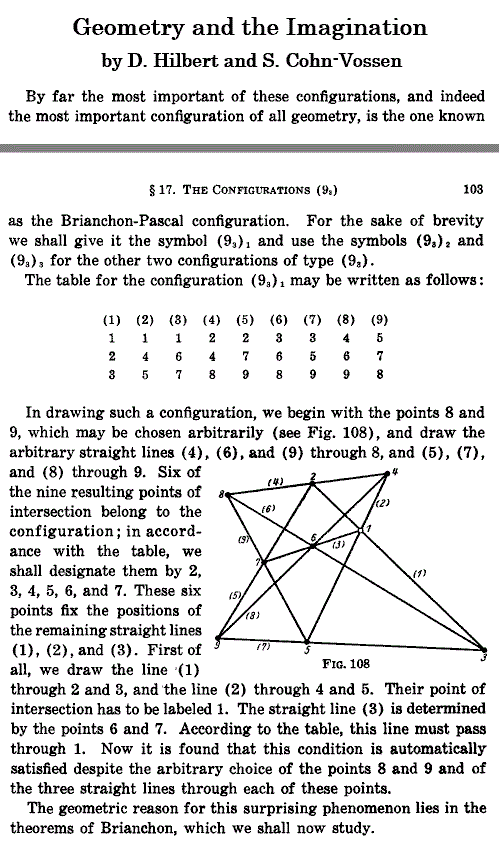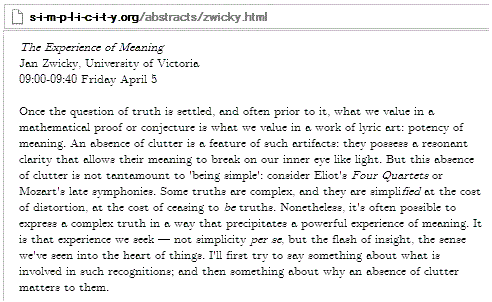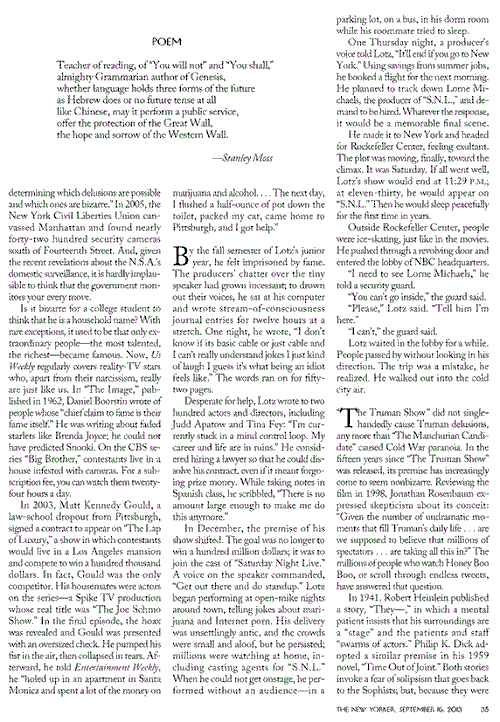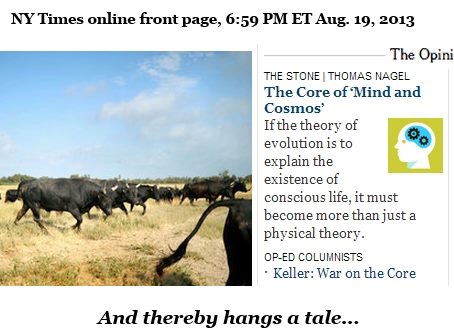Wednesday, September 11, 2013
Lexicon
The Eisenman Chronicles
Eisenman I: DuBois, PA (Of German descent)
Eisenman II: Yale (Apparently related to Eisenman I)
Eisenman III: Newark, NJ (Jewish)
"Confusion is nothing new." — Song lyric
Poem
In reply to "Poem," by Stanley Moss, in
the Sept. 16, 2012, New Yorker —
"Then we take Berlin." — Phrase by Leonard Cohen
See also this morning's 9:29 post Language Game.
Language Game
In which Plato continues to thank the Academy.
From the Academy, a lead balloon for 9/11 —
continued from March First, 2002.
A search today for the name Eisenman
(see previous post) yields the following :
"We need a cameo from Plato, a safecracker,
a wrinkle or two to be ironed out, some ice,
some diamonds, and, above all, laughter
for this irony of ironies."
— Jeffrey Kipnis, "Twisting the Separatrix,"
Assemblage No. 14, April 1991, MIT Press
A Girl’s Best Friend?*
Continued from September 3rd, 2013.
On that date, there were two posts in this journal:
"The Stone" today suggests…"* and
"An End in Itself."
The former dealt with some philosophy and
mathematics related to graphic design.
The latter dealt with death and finality.
The New York Times today has an obituary
that, revisiting Sept. 3rd, unites the topics of
death and design.
|
Alvin Eisenman,
By DANIEL E. SLOTNIK Alvin Eisenman, a graphic designer who in 1951 became the first director of Yale’s graduate program for graphic design, the first offered by a major American university, died on Sept. 3 at his home, which he also designed, on Martha’s Vineyard. He was 92. More>> |
For greater depth, see the American Institute of Graphic Arts.
* This post's title and "The Stone" above refer to the New York Times
philosophy column "The Stone"— In particular, to its Sept. 2nd post
"Women in Philosophy? Do the Math."
Tuesday, September 10, 2013
Kakutani on Pynchon
"A version of this review appears in print
on September 11, 2013,
on page C1 of the New York edition…."
Moss on the Wall
The following page from the Sept. 16, 2013, issue of The New Yorker
deals with current trends in paranoid schizophrenia. It may interest
fans of Philip K. Dick.
(Click for a larger, clearer image.)
As for the poem by Stanley Moss on the above page (35, by the way),
a quote from Wallace Stevens seems appropriate —
"It was a language he spoke, because he must, yet did not know.
It was a page he had found in the handbook of heartbreak."
For the "wall" theme of Moss, see (for instance), this journal
on June 3, 2013 — New Yorker Art.
"All in all…." — Pink Floyd
Monday, September 9, 2013
ART WARS Midrash
Viking Book
For the late Billy Wilder, director of Ace in the Hole (1951)
Click image for a larger version.
See, too, this morning's quarter-to-three post, and The Vikings (1958)—

The art by Josefine Lyche in the Bodin book shown
above is, as the artist notes, based on my own work.
Ace in the Hole
Some random thoughts suggested by the Norwegian ice hole
in the opening scene of the 2012 film Kon-Tiki .
From a Log24 post of August 2, 2013—
See, too, the secret life of Marsden Hartley :
Sunday, September 8, 2013
The Importance of Being Ernst
For John Cusack and Menno Meyjes —
"I still haven't found what I'm looking for." — Bono
"In fact Surrealism found what it had been looking for
from the first in the 1920 collages [by Max Ernst],
which introduced an entirely original scheme of visual structure…."
— Rosalind Krauss quoting André Breton*
in "The Master's Bedroom"
See also tonight's 10 PM post.
* "Artistic Genesis and Perspective of Surrealism" (1941),
in Surrealism and Painting (New York, Harper & Row, 1972, p. 64).
It’s 10 PM*


* The title and displayed time of this post is a fudge.
The post was actually put online at about 10:02 PM.
A surreal interpretation of that time as the date 10/02
yields a post from last October related to
this evening's previous post.
Crosses for Sherlock
"Take a cube, and write the numbers 1,…,6 on its faces.
Now the pairs of numbers on opposite faces
form a syntheme. (Standard dice, for example, represent
the syntheme 12|34|56.) "
— Peter J. Cameron, weblog post of May 11, 2010
"For every kind of vampire, there is a kind of cross."
— Gravity's Rainbow
Saturday, September 7, 2013
Structure and Character
(Continued from May 4, 2013)
"I saw a werewolf with a Chinese menu in his hand
Walking through the streets of Soho in the rain"
"It is well
That London, lair of sudden
Male and female darknesses,
Has broken her spell."
— D. H. Lawrence in a poem on a London blackout
during a bombing raid in 1917. See also today's previous
posts, Down Under and Howl.
Backstory— Recall, from history's nightmare on this date,
the Battle of Borodino and the second London Blitz.
Down Under
"If I am to have a meeting it shall be down,
down in the invisible,
and the moment I re-emerge
it shall be alone.
In the visible world I am alone, an isolate instance.
My meeting is in the underworld, the dark."
— D. H. Lawrence, Kangaroo , Chapter 7,
"The Battle of Tongues."
The web edition of this book says it was
"Last updated Tuesday, June 18, 2013."
This was also the publication date of Max Barry's
2013 novel Lexicon . (See that date in this journal.)
Friday, September 6, 2013
Space
"A vast space that travels down to the bedrock
upon which the towers were built, the museum
winds its way deeper and deeper underground,
taking visitors on a journey to the very bottom."
— The Associated Press in
this evening's Washington Post
This suggests a review of a different sort of
bedrock:—

"If you have built castles in the air,
your work need not be lost;
that is where they should be.
Now put the foundations under them.”
— Henry David Thoreau
Oblivion
"Born of blood and tribulation"
— Gangs of New York

"Oblivion is not to be hired: The greater part must be content
to be as though they had not been, to be found in the Register
of God, not in the record of man."
— Sir Thomas Browne
The part of the above quotation preceding the first comma may be
found, among other places, in a New York Times piece published
online on August 7, 2012. See also this journal on that date.
Thursday, September 5, 2013
An Effective Team:
Underworld and Evolution
This journal on 9/11, 2009 —
Poster for Kate Beckinsale in a film
released on 9/11, 2009 —
For Qohen Leth — A quotation from
this journal on 9/11, 2009 —
"Time and chance
happeneth to them all."
— Ecclesiastes 9:11
Kernel and Glow
"The yarns of seamen have a direct simplicity, the whole meaning
of which lies within the shell of a cracked nut. But Marlow was not
typical (if his propensity to spin yarns be excepted), and to him the
meaning of an episode was not inside like a kernel but outside,
enveloping the tale which brought it out only as a glow brings out a
haze, in the likeness of one of these misty halos that sometimes
are made visible by the spectral illumination of moonshine."
— Joseph Conrad in Heart of Darkness
Kernel — See Nocciolo.
Glow — See Moonshine and Moonshine II.
See also Cold Open (Jan. 29, 2011) and
Where Entertainment is God (Aug. 25, 2013).
Wednesday, September 4, 2013
Secretary
Margalit Fox in The New York Times this evening—
Judith Daniels, the founding editor in chief of Savvy ,
the first glossy magazine aimed at executive women,
died on Sunday at her home in Union, Me. She was 74….
“Savvy will not tell you how to be a good secretary,”
one of its early promotional fliers read. “Savvy will tell you
how to hire a good secretary— and how to fire.”
From the date of Daniels' death: The Crossword Omen.
See, too, Vogue in this journal and Ontology.
From a post of January 26, 2013—

Sally in the 2013 film Oblivion : "Are you an effective team?"
Tuesday, September 3, 2013
An End in Itself
Continued from August 29th
"The general mood was summed up by fan
Debra Kay, who tweeted simply: 'R.I.P. Frederik Pohl.
Thanks for the stories.'" — The Guardian today
Pohl reportedly died Monday.
A synchronicity check: Quoted here Monday—

See also this journal on August 5th, 2008—
“The Stone” Today Suggests…
|
The Philosopher's Gaze , by David Michael Levin, The post-metaphysical question—question for a post-metaphysical phenomenology—is therefore: Can the perceptual field, the ground of perception, be released from our historical compulsion to represent it in a way that accommodates our will to power and its need to totalize and reify the presencing of being? In other words: Can the ground be experienced as ground? Can its hermeneutical way of presencing, i.e., as a dynamic interplay of concealment and unconcealment, be given appropriate respect in the receptivity of a perception that lets itself be appropriated by the ground and accordingly lets the phenomenon of the ground be what and how it is? Can the coming-to-pass of the ontological difference that is constitutive of all the local figure-ground differences taking place in our perceptual field be made visible hermeneutically, and thus without violence to its withdrawal into concealment? But the question concerning the constellation of figure and ground cannot be separated from the question concerning the structure of subject and object. Hence the possibility of a movement beyond metaphysics must also think the historical possibility of breaking out of this structure into the spacing of the ontological difference: différance , the primordial, sensuous, ekstatic écart . As Heidegger states it in his Parmenides lectures, it is a question of "the way historical man belongs within the bestowal of being (Zufügung des Seins ), i.e., the way this order entitles him to acknowledge being and to be the only being among all beings to see the open" (PE* 150, PG** 223. Italics added). We might also say that it is a question of our response-ability, our capacity as beings gifted with vision, to measure up to the responsibility for perceptual responsiveness laid down for us in the "primordial de-cision" (Entscheid ) of the ontological difference (ibid.). To recognize the operation of the ontological difference taking place in the figure-ground difference of the perceptual Gestalt is to recognize the ontological difference as the primordial Riß , the primordial Ur-teil underlying all our perceptual syntheses and judgments—and recognize, moreover, that this rift, this division, decision, and scission, an ekstatic écart underlying and gathering all our so-called acts of perception, is also the only "norm" (ἀρχή ) by which our condition, our essential deciding and becoming as the ones who are gifted with sight, can ultimately be judged. * PE: Parmenides of Heidegger in English— Bloomington: Indiana University Press, 1992 ** PG: Parmenides of Heidegger in German— Gesamtausgabe , vol. 54— Frankfurt am Main: Vittorio Klostermann, 1992 |
Examples of "the primordial Riß " as ἀρχή —

For an explanation in terms of mathematics rather than philosophy,
see the diamond theorem. For more on the Riß as ἀρχή , see
Function Decomposition Over a Finite Field.
Monday, September 2, 2013
Analogy
From The New York Times Sunday Book Review of Sept. 1, 2013—
|
THE GAMAL Reviewed by Katharine Weber Ten years ago, when Mark Haddon’s “Curious Incident of the Dog in the Night-Time” turned up on the best-seller list and won a number of literary awards, the novel’s autistic narrator beguiled readers with his unconventional point of view. Today, even as controversy surrounds the revised classification of autism in the latest version of the American Psychiatric Association’s Diagnostic and Statistical Manual of Mental Disorders, the quirky yet remarkably perceptive points of view of autistic narrators have become increasingly familiar in every category of fiction, from young adult to science fiction to popular and literary fiction. Like Haddon’s Christopher Boone, the narrator of Ciaran Collins’s remarkable first novel, “The Gamal,” has been encouraged by a mental health professional to write his story for therapeutic purposes. Charlie McCarthy, 25, is known in the West Cork village of Ballyronan as “the gamal,” short for “gamalog,” a term for a fool or simpleton rarely heard beyond the Gaeltacht regions of Ireland. He is in fact a savant, a sensitive oddball whose cheeky, strange, defiant and witty monologue is as disturbing as it is dazzling. … |
The Gamal features a considerable variety of music. See details at a music weblog.
This, together with the narrator's encouragement "by a mental health professional
to write his story for therapeutic purposes" might interest Baz Luhrmann.
See Luhrmann's recent film "The Great Gatsby," with its portrait of
F. Scott Fitzgerald's narrator, and thus Fitzgerald himself, as a sensitive looney.
The Carraway-Daisy-Gatsby trio has a parallel in The Gamal . (Again, see
the music weblog's description.)
The Times reviewer's concluding remarks on truth, lies, and unreliable autistic
narrators may interest some mathematicians. From an Aug. 29 post—

A different gamalog , a website in Mexico, is not entirely unrelated to
issues of lies and truth—
Sunday, September 1, 2013
Argo
For the late actor Victor Argo, a religious symbol : the Krauss Cross.
Some backstory :
"Now don't tell me… You're St. Peter."
— James Bond in Diamonds Are Forever
For a life of Victor Argo, see The New York Times
on April 9, Good Friday, 2004.
The Crossword Omen
August 30, 11:01 AM Comment-Worthy
August 30, 12:00 PM Hymn
August 31, 8:23 PM What Where
September 1, 5:48 AM The Crossword Omen —
Related material: A critic's remarks on the missing character "Bum"
in Beckett's play "What Where" and Rimbaud on the vowel "U"—
Saturday, August 31, 2013
What Where
The news item at lower right in the above image, with the phrase "surprise U-turn,"
suggests some remarks related to this summer's Enniskillen festival.
Friday, August 30, 2013
Her
(A sequel to today's noon post, Hymn)
Portrait, in the 2013 film Oblivion , of a 2005 graduate
of London's Royal Academy of Dramatic Art —
London derrière.
Hymn
"By recalling the past and freezing the present
he could open the gates of time…."
— Mark Helprin, In Sunlight and in Shadow
Thursday, August 29, 2013
An End in Itself
(Mathematics and Narrative, continued from May 9, 2013)

See also Scriba's The Concept of Number and,
from the date of his death, The Zero Theorem.
Wednesday, August 28, 2013
Noir sur Blanc
Some backstory for this post's title—
A post from the day of Mrozek's death may also be relevant—
Tuesday, August 27, 2013
What Seems Insanity
On a way of seeing— superimposition—
that "seems insanity" (cf. C. S. Lewis's remarks below)
Combining last night's post Spectrum with
the August 14 post Valhalla Is Down…
From An Experiment in Criticism
by C.S. Lewis, 1961–
"If we go steadily through all the myths of any people
we shall be appalled by much of what we read.
Most of them, whatever they may have meant to
ancient or savage man, are to us meaningless and
shocking; shocking not only by their cruelty and
obscenity but by their apparent silliness— almost
what seems insanity. Out of this rank and squalid
undergrowth the great myths— Orpheus, Demeter
and Persephone, the Hesperides, Balder, Ragnarok,
or Ilmarinen's forging of the Sampo– rise like elms."
Voilà —

The Aug. 14 post Valhalla Is Down referred to a New York Times blackout.
(Jill Abramson, on earlier being named executive editor at the Times, had
said it was like "ascending into Valhalla.")
Another Times blackout occurred today.
Lewis's term Ragnarok refers to the twilight of the gods of Valhalla.
A more conventional illustration from the gamer website Ragnarok/Valhalla Wiki —

Perspective
For Fans of Bad Movies*
This post was suggested by my viewing last night
the 1995 horror film Species , and by news that
Scarlett Johansson will be starring in a similar
production at the Venice Film Festival, which
opens tomorrow.
The new Johansson film, Under the Skin ,
is based on a novel by one Michel Faber.
Faber on books that have influenced him—
"Most influential has possibly been John Berger's Ways of Seeing —
not a novel at all (although Berger has written fiction) but a book of
art criticism. The influence of these wonderfully perceptive and
thought-provoking essays peeps out everywhere in my own work."
An excerpt from the Berger book—
Click image for a better view of the original.
Related material: Johansson in this journal, Sunday's NY Times
teaser for a piece on Saturday Night Live, and a more serious
approach to the geometry of perspective.
* And of Ben Kingsley, who starred both in Species and in
a previous film by the director of Under the Skin .
Monday, August 26, 2013
Spectrum
From the weblog of Dr. David Justice today :
C.S. Lewis somewhere (in time, in retirement, I might recover
the passage) surveys the spectrum of plot-outlines, and notes
that that of Orpheus retains its power to spellbind, even in a
bare-bones form, whereas that of almost all worthy modern novels,
become as dust upon such summary.
We venture now upon that territory where words fail ….
Related material :
C. S. Lewis on Orpheus (click to enlarge) —
Lewis, according to Justice, "surveys the spectrum of plot-outlines."
A related image (see, too, today's previous post) —

C. S. Lewis on myth —
"The stories I am thinking of always have a very simple narrative shape—
a satisfactory and inevitable shape, like a good vase or a tulip."
Conceptual Art
For concepts of prism, spectrum, and tulip combined, see Sicilian Reflections.
"For every kind of vampire, there is a kind of cross."
— Gravity's Rainbow
Dark Side Tales
"Got to keep the loonies on the path."
— Lyrics to Dark Side of the Moon
For those who, like Tom Stoppard, prefer the dark side—
|
NEW ANGLE:
INT. OFFICE BUILDING – NIGHT
NIGHT WATCHMAN
Bateman wheels around and shoots him.
NEW ANGLE:
INT. PIERCE & PIERCE LOBBY – NIGHT
— AMERICAN PSYCHO |
Not quite so dark—
"And then one day you find ten years have got behind you."
— Lyrics to Dark Side of the Moon
This journal ten years ago, on August 25, 2003—
|
… We seek
The poem of pure reality, untouched
At the exactest point at which it is itself,
The eye made clear of uncertainty, with the sight
Everything, the spirit's alchemicana
The solid, but the movable, the moment,
— Wallace Stevens, "An Ordinary Evening |
"A view of New Haven, say…." —
"This is the garden of Apollo,
the field of Reason…."
John Outram, architect
A similar version of this Apollonian image —

Detail:
![]()
Related material for the loonies:
Sunday, August 25, 2013
Where Entertainment Is God
For film and TV director Ted Post, who
reportedly died on Tuesday, Aug. 20.
See that day's post "Conversations with
an Empty Chair" and today's NY Times—
Saturday, August 24, 2013
Being’s Road
For the late Julie Harris —
By slow and carefully modulated steps Bradford's narrative
has brought his community of separatists to the place he
calls Cape Harbor… where, face-to-face with the bleak
and wintry reduction that is his image for American space,
he finds himself stopped, able to do nothing but come to
an astonished pause. The final step, that of imaginative
crossing into the land that lies before them, remains
beyond the power of narrative to take. Narrative falters, and
finding his journey advanced to an "odd Fork in Being's Road"
and himself nothing so much as an "empty spirit / In vacant
space" (to adopt apt phrases from Dickinson and Stevens…),
Bradford requires the sublime if he is to continue moving
forward: separation becomes exaltation as it becomes
manifest that only an influx of "the Spirit of God and His
grace" can have permitted the community to survive its
passage to the limit depicted.
— David Laurence, "William Bradford's American Sublime,"
PMLA , Vol. 102, No. 1, 1987, pp. 55-65
Cast (continued)
The death yesterday of British cinematographer
Gilbert Taylor suggests an image from last evening's
Log24 search Point Omega —
 .
.
The die in the above image (shown here Dec. 28, 2012)
displays the numbers 3-6-5 in counterclockwise order.
A similar die in an earlier post served as a metaphor for
a time-jump to 365 days in the past.
For some religious remarks by Umberto Eco that may
serve as a small memorial to Taylor, see this journal
a year before the day he died— August 23, 2012.
Friday, August 23, 2013
Vacant Space
A passage from Wallace Stevens—
The spirit and space,
The empty spirit
In vacant space.
A frame from the film American Psycho (2000), starring Christian Bale—

The rest of the film is not recommended.
Related material—
"24 Hour Psycho" at the Museum of Modern Art in the novel Point Omega .
Illustration from a New York Times review—
Ten Years of Nothing
For insatiable actor Patrick Bateman (protagonist of
American Psycho) and anti-theologian Kirk Varnedoe
( Pictures of Nothing, this journal ten years ago today )
|
Philip Rieff, The Crisis of the Officer Class,
The third culture's life-style, its way, is no way: it is abandonment,
proclaims
This is masterly anti-theology. This is what no "mickey mockers" of
[12] Wallace Stevens, "To the One of Fictive Music," in Collected
velous panic and emptiness of belief by which the "sublime comes
The spirit and space,
This poet is no great character, nor temple priest. He is a virtuoso
[13] Stevens, "The American Sublime," 130-31 |
Thursday, August 22, 2013
Wednesday, August 21, 2013
The 21
A useful article on finite geometry,
"21 – 6 = 15: A Connection between Two Distinguished Geometries,"
by Albrecht Beutelspacher, American Mathematical Monthly ,
Vol. 93, No. 1, January 1986, pp. 29-41, is available for purchase
at JSTOR.
This article is related to the geometry of the six-set.
For some background, see remarks from 1986 at finitegeometry.org.
Jazz Saint
From an obituary of a jazz pianist and host of
a radio interview program on jazz —
McPartland said the conversations themselves
were very much like jazz, spontaneous and
free-flowing.
"It's so easy to make it a conversation, and
you don't know where it's going to lead,"
McPartland said.
See, too, last night's Conversations with an Empty Chair .
Tuesday, August 20, 2013
Conversations with an Empty Chair
(Continued from 4 AM Sunday, Sept. 10, 2006 —
Meet Max Black .)
In memory of office chair designer Charles Pollock,
who reportedly died today at 83.

An image from the 2006 Meet Max Black empty-chair post
appears also in today's previous post, The 20 .
The conversation of this post's title (see The 20 ) —

The 20
In memory of author Elmore Leonard—
A graphic symbol and a search for "Nowhere"*
in this journal yield…
|
Pictorial version |
"Cotton Mather died
— Wallace Stevens, |
* See previous post.
Monday, August 19, 2013
Tale
The tale is not Thomas Nagel's remarks on philosophy
summarized above, but rather the late John Hollander's
remarks on Nowhere:
"We all know where it is they've gone, the dead:
Beyond Noplace, far into wide Nowhere."
See also Nagel's book The View from Nowhere .
Noon
Last midnight's post quoted poet John Hollander
on Cervantes—
"… the Don’s view of the world is correct at midnight,
and Sancho’s at noon."
The post concluded with a figure that might, if
rotated slightly, be regarded as a sort of Star of
David or Solomon's Seal. The figure's six vertices
may be viewed as an illustration of Pascal's
"mystic hexagram."

Pacal's hexagram is usually described
as a hexagon inscribed in a conic
(such as a circle). Clearly the hexagon
above may be so inscribed.
The figure suggests that last midnight's Don be
played by the nineteenth-century mathematician
James Joseph Sylvester. His 1854 remarks on
the nature of geometry describe a different approach
to the Pascal hexagram—
| "… the celebrated theorem of Pascal known under the name of the Mystic Hexagram, which is, that if you take two straight lines in a plane, and draw at random other straight lines traversing in a zigzag fashion between them, from A in the first to B in the second, from B in the second to C in the first, from C in the first to D in the second, from D in the second to E in the first, from E in the first to F in the second and finally from F in the second back again to A the starting point in the first, so as to obtain ABCDEF a twisted hexagon, or sort of cat's-cradle figure and if you arrange the six lines so drawn symmetrically in three couples: viz. the 1st and 4th in one couple, the 2nd and 5th in a second couple, the 3rd and 6th in a third couple; then (no matter how the points ACE have been selected upon one of the given lines, and BDF upon the other) the three points through which these three couples of lines respectively pass, or to which they converge (as the case may be) will lie all in one and the same straight line." |
For a Sancho view of Sylvester's "cat's cradle," see some twentieth-century
remarks on "the most important configuration of all geometry"—

"Now look, your grace," said Sancho,
"what you see over there aren't giants,
but windmills, and what seems to be arms
are just their sails, that go around in the wind
and turn the millstone."
"Obviously," replied Don Quijote,
"you don't know much about adventures.”
Midnight in the Garden
From a 2003 interview by Paul Devlin (PD) with poet John Hollander (JH),
who reportedly died Saturday—
|
PD: You wrote in the introduction to the new edition of Reflections on Espionage that whenever you have been "free of political callowness" it was partly as a result of reading W.H. Auden, George Orwell, and George Bernard Shaw. Do you think these writers might possibly be an antidote to political callowness that exists in much contemporary literary criticism? JH: If not they, then some other writers who can help one develop within one a skepticism strongly intertwined with passion, so that each can simultaneously check and reinforce the other. It provides great protection from being overcome by blind, true-believing zeal and corrupting cynicism (which may be two sides of the same false coin). Shaw was a great teacher for many in my generation. I started reading him when I was in sixth grade, and I responded strongly not only to the wit but to various modes, scene and occasions of argument and debate as they were framed by various kinds of dramatic situation. I remember being electrified when quite young by the moment in the epilogue scene of Saint Joan when the English chaplain, De Stogumber, who had been so zealous in urging for Joan’s being burned at the stake, returns to testify about how seeing her suffering the flames had made a changed man of him. The Inquisitor, Peter Cauchon, calls out (with what I imagined was a kind of moral distaste I’d never been aware of before), "Must then a Christ perish in torment in every age to save those who have no imagination?" It introduced me to a skepticism about the self-satisfaction of the born-again, of any persuasion. With Auden and Orwell, much later on and after my mental world had become more complicated, it was education in negotiating a living way between a destructively naïve idealism and the crackpot realism—equally inimical to the pragmatic. PD: Would you consider yourself a "formal" pragmatist, i.e., a student of Peirce, James, Dewey, Mead (etc.) or an "informal" pragmatist – someone taking the common-sense position on events…or someone who refuses to be pigeon-holed politically? JH: "Informal" – of the sort that often leads me to ask of theoretical formulations, "Yes, but what’s it for ?" PD: Which other authors do you think might help us negotiate between "naïve idealism" and "crackpot realism"? I think of Joyce, Wallace Stevens, perhaps Faulkner? JH: When I was in college, a strong teacher for just this question was Cervantes. One feels, in an Emersonian way, that the Don’s view of the world is correct at midnight, and Sancho’s at noon. |
Then there is mathematical realism.
A post in this journal on Saturday, the reported date of Hollander's death,
discussed a possible 21st-century application of 19th-century geometry.
For some background, see Peter J. Cameron's May 11, 2010, remarks
on Sylvester's duads and synthemes . The following figure from the
paper discussed here Saturday is related to figures in Cameron's remarks.

Sunday, August 18, 2013
The Company He Keeps
Alexander Pierce and Black Widow, scheduled
to appear in Captain America: The Winter Soldier
on April 4, 2014—

"God, isn't there already enough crap in this story?"
— Margaret Soltan, quoted here on Aug. 7, 2007
Happy birthday, Robert Redford.
Seeing a Form
A book noted here on Sept. 16, 2010—
On that date, Harvard historian of science
John E. Murdoch died.
"It's still the same old story…"
Related material: Faust + Potter in this journal.
Happy birthday, Roman Polanski.
Today in History
Academy Award-winning director Roman Polanski is 80.
Actor-director Robert Redford is 77.
Actor-comedian Martin Mull is 70.
— The Associated Press
Related material —
… and Your Shiny Friend.
Saturday, August 17, 2013
The Story of N…
Up-to-Date Geometry
The following excerpt from a January 20, 2013, preprint shows that
a Galois-geometry version of the large Desargues 154203 configuration,
although based on the nineteenth-century work of Galois* and of Fano,**
may at times have twenty-first-century applications.

Atkinson's paper does not use the square model of PG(3,2), which later
in 2013 provided a natural view of the large Desargues 154203 configuration.
See my own Classical Geometry in Light of Galois Geometry. Atkinson's
"subset of 20 lines" corresponds to 20 of the 80 Rosenhain tetrads
mentioned in that later article and pictured within 4×4 squares in Hudson's
1905 classic Kummer's Quartic Surface.
* E. Galois, definition of finite fields in "Sur la Théorie des Nombres,"
Bulletin des Sciences Mathématiques de M. Férussac,
Vol. 13, 1830, pp. 428-435.
** G. Fano, definition of PG(3,2) in "Sui Postulati Fondamentali…,"
Giornale di Matematiche, Vol. 30, 1892, pp. 106-132.
Friday, August 16, 2013
Inglorious

(From French Wikipedia. Click image for
more about the Théâtre de la Madeleine.*)
For Le Salaud Lumineux ("The Brilliant Bastard"),
a Devil's advocate who reportedly died on August 15—
a quotation from this journal linked to here on that date—
"To me, the most genuine last words are those
that arise naturally from the moment, such as
Voltaire’s response to a request that he forswear
Satan: 'This is no time to make new enemies.' "
— Christopher Orlet, The Vocabula Review
(http://www.vocabula.com/index.asp)
July/August 2002 Issue, as quoted in
Utne Reader
* Le Théâtre de la Madeleine is apparently named for
its proximity to L'Église de la Madeleine .
Six-Set Geometry
From April 23, 2013, in
"Classical Geometry in Light of Galois Geometry"—
Click above image for some background from 1986.
Related material on six-set geometry from the classical literature—
Baker, H. F., "Note II: On the Hexagrammum Mysticum of Pascal,"
in Principles of Geometry , Vol. II, Camb. U. Press, 1930, pp. 219-236
Richmond, H. W., "The Figure Formed from Six Points in Space of Four Dimensions,"
Mathematische Annalen (1900), Volume 53, Issue 1-2, pp 161-176
Richmond, H. W., "On the Figure of Six Points in Space of Four Dimensions,"
Quarterly Journal of Pure and Applied Mathematics , Vol. 31 (1900), pp. 125-160
Thursday, August 15, 2013
The Crosswicks Curse
(Continued from previous posts)
A check of today's date in this journal
ten years ago yields a reference to the
Brazilian artist Athos Bulcão.
It turns out he died on July 31, 2008.
See that date in this journal.
History’s Nightmare…
… Continues.
See Quine + Boxer in this journal.
Wednesday, August 14, 2013
Valhalla Is Down
Odin's Day continues.
The title is a reference to the recent film
"Olympus Has Fallen," directed by Antoine Fuqua
(which I watched last night).
Related material:
Ascent to Valhalla, Times Blackout,
and the post-blackout Times Obituaries.
Update of 6:45-7:59 PM Aug. 14:
See also (in keeping with the ART WARS
theme of today's previous post)
Juneteenth (Wednesday, June 19) 2013.
This last link may be regarded as posted in
memory of author Vince Flynn, who reportedly
died at about 2 AM on that date. Background:
Tuesday, June 18.
ART WARS
(Continued from 24 hours ago and from May 9, 2012)
Quoted 24 hours ago in this journal—
Remark by Aldous Huxley on an artist's work:
"All the turmoil, all the emotions of the scenes
have been digested by the mind into a
grave intellectual whole."
Quoted in a video uploaded on May 9, 2012:
Norway Toilet Scene

Norway dance (as interpreted by an American)

I prefer a different, Norwegian, interpretation of "the dance of four."
Related material: The clash between square and tetrahedral versions of PG(3,2).
The Gift
"Give 'em hell." — Ben Bernanke at Princeton's Baccalaureate, 2013
Some background — Janet Leigh and the Museum of Modern Art
"The Varnedoe Debacle," by Hilton Kramer (Dec. 1991)
Hell… Hell. — Sinatra in The Manchuran Candidate
Tuesday, August 13, 2013
The Story of N
(Continued from this morning)

The above stylized "N," based on
an 8-cycle in the 9-element Galois field
GF(9), may also be read as an Aleph.
Graphic designers may prefer a simpler,
bolder version:

Plan 9
(Continued from August 28 last year)
Backstory—
Reflections from today's date, August 13, in 2003, that included
the following remark by Aldous Huxley on an artist's work:
"All the turmoil, all the emotions of the scenes
have been digested by the mind into a
grave intellectual whole. It is as though
Bach had written the 1812 Overture."
Related art—
Josefine Lyche, from her 2013 Crackquarelle series:

Steven H. Cullinane, The Story of N ,
from The Misalignment of Mars and Venus series:

See, too, previous posts on The Story of N.
Monday, August 12, 2013
To the Day
Form
The Galois tesseract appeared in an early form in the journal
Computer Graphics and Art , Vol. 2, No. 1, February 1977—
The Galois tesseract is the basis for a representation of the smallest
projective 3-space, PG(3,2), that differs from the representation at
Wolfram Demonstrations Project. For the latter, see yesterday’s post.
The tesseract representation underlies the diamond theorem, illustrated
below in its earliest form, also from the above February 1977 article—
As noted in a more recent version, the group described by
the diamond theorem is also the group of the 35 square
patterns within the 1976 Miracle Octad Generator (MOG) of
R. T. Curtis.
Sunday, August 11, 2013
Saturday, August 10, 2013
Friday, August 9, 2013
Hell’s Bells
"Ting-a-ling" — Timequake
See also Catholic Analyst's Couch.
Thursday, August 8, 2013
Jesus for Jews
(Continued from the previous post, with its
link to Jeff Bridges in a scene from "Heaven's Gate.")
See an obituary for the widow of the late Robert Maxwell
in today's Jerusalem Post , and The Dude.
Related material: Peter O'Toole as another Jesus for Jews.
And then there is Liam Neeson….
Heaven’s Gate
Yesterday's post Devil's Gate provided a dark view of life and culture.
A more cheerful view is provided by the late Gail Levin,
a maker of PBS "American Masters" documentaries
that included, notably, Jeff Bridges and Marilyn Monroe.
Levin reportedly died at 67 on July 31, 2013.*
An image from an interview with Levin —
The date in the image, July 19th, 2006, is the broadcast
date of the PBS "American Masters" program on Monroe.
A check for synchronicity shows there was no Log24 post
on that date.
See, however, posts for the day before— "Sacred Order"—
and the day after— "Bead Game."
A related quote from an article linked to in the latter—
"First world culture, which is 'pagan and in the majority
everywhere,' has as its defining characteristic
a 'primacy of possibility,' or pop— a broadly inclusive
concept that covers everything from the Aboriginal
dreamtime to Plato’s Forms."
— Review by Jess Castle of Philip Rieff’s
Sacred Order/Social Order, Vol. 1: My Life among the
Deathworks: Illustrations of the Aesthetics of Authority,
University of Virginia Press, 2006. 256 pages, $34.95.
This quote may serve as the missing July 19, 2006, post.
Related material: Dreamtime, Possibility, and Plato's Forms.
* See that date in this journal for two less famous American
masters, artist Edward Valigursky and writer Robert Silverberg.
Wednesday, August 7, 2013
Tuesday, August 6, 2013
Desargues via Galois
The following image gives a brief description
of the geometry discussed in last spring's
Classical Geometry in Light of Galois Geometry.

Update of Aug. 7, 2013: See also an expanded PDF version.
Levity
Monday, August 5, 2013
Diamond Theorem in ArXiv
The diamond theorem is now in the arXiv—
Wikipedia Updates
I added links today in the following Wikipedia articles:
- Diamond theorem (disambiguation page)
- Miracle Octad Generator
- Binary Golay code
The links will probably soon be deleted,
but it seemed worth a try.
Saturday, August 3, 2013
In the Details
By chance, the latest* remarks in philosopher Colin McGinn's
weblog were posted (yesterday) at 10:04 AM.
Checking, in my usual mad way, for synchronicity, I find
the following from this weblog on the date 10/04 (2012)—
- The Shining (politics and philosophy)
- Big Bird (Kerouac on jazz)
- Kids Grow Up (children's books and philosophy)
Note too the time of this morning's previous post here
(on McGinn)— 9:09 AM. Another synchronistic check
yields Log24 posts from 9/09 (2012):
- Decomposition Sermon (mathematics and poetry)
- Grid Compass (philosophy and death)
Related to this last post:
Detail from a stock image suggested by the web page of
a sociologist (Harvard '64) at the University of Washington in Seattle—

Note, on the map of Wyoming, Devil's Gate.
There are, of course, many such gates.
* Correction (of about 11:20 AM Aug. 3):
Later remarks by McGinn were posted at 10:06 AM today.
They included the phrase "The devil is in the details."
Yet another check for synchronicity leads to
10/06 (2012) in this journal with its post related to McGinn's
weblog remarks yesterday on philosophy and art.
That 10/06 Log24 post is somewhat in the spirit of other
remarks by McGinn discussed in a 2009 Harvard Crimson review.
The Lotos Rose
See the title in this journal.
Related material:
Philosophers on the Beach—
George Santayana in Acapulco, Colin McGinn in Miami.
Friday, August 2, 2013
Parts of a World
"When an irresistible force such as you
meets an old immovable object like me…"
— From one whose name was writ in water*
* Scholia: Art Wars, Conceptual Coffee, and Day of the Tetraktys
Duende for St. Wallace

(The final quote above is bogus. Stevens did write "Death is the mother
of beauty," but the "perishable" part is from a lesser poet, Billy Collins.)
For the duende of this post's title, see a dance.
The dance suggests a 1956 passage by Robert Silverberg—
"There was something in the heart of the diamond—
not the familiar brown flaw of the others, but something
of a different color, something moving and flickering.
Before my eyes, it changed and grew.
And I saw what it was. It was the form of a girl—
a woman, rather, a voluptuous, writhing nude form
in the center of the gem. Her hair was a lustrous blue-black,
her eyes a piercing ebony. She was gesturing to me,
holding out her hands, incredibly beckoning from within
the heart of the diamond.
I felt my legs go limp. She was growing larger, coming closer,
holding out her arms, beckoning, calling—
She seemed to fill the room. The diamond grew to gigantic size,
and my brain whirled and bobbed in dizzy circles.
I sensed the overpowering, wordless call."
— "Guardian of the Crystal Gate," August 1956
For similar gestures, see Nicole Kidman's dance in "The Human Stain."
Thursday, August 1, 2013
Conceptual Duende
For a conceptual artist who reportedly died
on Thursday, July 25, 2013—
Related material: Art Saint and Wisdom & Metaphor .
Art and Death
Yesterday afternoon's post, combined with Tom Wolfe's
remarks on conceptual art quoted here July 23 and an
obituary this morning for a conceptual artist who reportedly
died on July 25, suggest a review of this journal's content
from the day of the artist's reported death—
"Und was für ein Bild des Christentums
ist dabei herausgekommen?"
Wednesday, July 31, 2013
A Consolatory Tale
The title is taken from Isak Dinesen— See the previous post,
which posed the question, "Stylist or fraud?"
Stylist and fraud—
The stylist: Gerard Manley Hopkins, Society of Jesus
The fraud (i.e., the fiction):
Click on the cover art for further details.
The cover artist, by the way, died on the date*
mentioned prominently in the previous post.
* September 7, 2009.
See also that date in this journal, with its post
"Magic Boxes." Happy birthday, J. K. Rowling.
The Question
Maya Alexandri on September 7, 2009—
|
… Blixen herself may have cut closer to the truth In it, a character explains,
What exactly [the imposter to the Prince] has told
Later, the imposter utters the following enigma: "Life and Death Stylist or fraud, that's the question. |
Tuesday, July 30, 2013
St. Julia’s Day
For mathematician Julia Robinson, who died on this date
in 1985, and her sister Constance Reid, who died on
October 14, 2010—
A search suggested by the "cosmic dippiness" of
a 1998 science fiction novel and by the non-dippiness of
a much better novel with closely related themes from 1977—
(The use of "recursive" here is of course rather poetic, not to be
construed as meaningful in the strictly mathematical sense.
See also the term's etymology, and Working Backwards.)
Monday, July 29, 2013
St. Walter’s Day
Today is the dies natalis of group theorist Walter Feit.
"The Steiner systems S (5,6,12) and S (5,8,24) are remarkable combinatorial
configurations unlike any others. Their automorphism groups are the Mathieu
groups M12 and M24. These are the only 5-transitive permutation groups other
than symmetric and alternating groups: (a fact long conjectured but only
proved as a consequence of the classification). The Leech lattice is a blown up
version of S (5,8,24). It is the unique even unimodular lattice in 24 dimensions
with no vectors of weight 2. This uniqueness is an essential reason why it is a
geometric object of fundamental importance. The automorphism group Co.O
of the Leech lattice involves about half of the sporadic groups and generally it
is felt that these are well understood."
— Walter Feit, book review, Bulletin of the American Mathematical Society ,
Vol. 8 (1983), 120-124, page 123
Papiere, Bitte!
For a memorable eccentric who reportedly died
on Wednesday, July 24, 2013—
-
A photo collection of other eccentrics at
halmos.tumblr.com with a concluding note
dated April 10, 2013 -
Log24 posts from that date, which might
be summarized as "This way to the egress" - A musical version of that theme
Sunday, July 28, 2013
Sermon
(Simplicity continued)
"Understanding a metaphor is like understanding a geometrical
truth. Features of various geometrical figures or of various contexts
are pulled into revealing alignment with one another by the
demonstration or the metaphor.
What is 'revealed' is not that the alignment is possible; rather,
that the alignment is possible reveals the presence of already-
existing shapes or correspondences that lay unnoticed. To 'see' a
proof or 'get' a metaphor is to experience the significance of the
correspondence for what the thing, concept, or figure is ."
— Jan Zwicky, Wisdom & Metaphor , page 36 (left)
Zwicky illustrates this with Plato's diamond figure
from the Meno on the facing page— her page 36 (right).
A more sophisticated geometrical figure—
Galois-geometry key to
Desargues' theorem:
| D | E | F | |
| S' | P | Q | R |
| S | P' | Q' | R' |
| O | P1 | Q1 | R1 |
For an explanation, see
Classical Geometry in Light of Galois Geometry.
Saturday, July 27, 2013
Simplicity
(Continued from July 16)
From the schedule of an April 2013 philosophical conference:

Why should anyone care what Zwicky thinks?
1. Her writings. In particular, Plato as Artist .
2. Her husband. See Robert Bringhurst in this journal.
3. A reading by Zwicky and Bringhurst on March 20, 2013.
Friday, July 26, 2013
Frank Discussion
Related material: Weiner news
Update of 3:30 AM:
A meditation on the above
headline phrase "widely published."
Thursday, July 25, 2013
Rhetorical Question
"Und was für ein Bild des Christentums
ist dabei herausgekommen?"
Wednesday, July 24, 2013
Dark Humor
Arts and Letters Daily today links to a July 17
Washington Post review of two books on the
occult and the enlightenment. The review, by
Michael Dirda, ends on a cheerful note:
"Happy synchronicity."
In related news, a Walpurgisnacht obituary also
ends cheerfully:
"He was still trying to get out a joke
with his final breath."
That obituary describes a life that reportedly ended
on April 21, 2013. Synchronicity involving that date—
The posts of April 21, 2013 (and related material in
this morning's previous post).
The Broken Tablet
This post was suggested by a search for the
Derridean phrase "necessary possibility"* that
led to web pages on a conference at Harvard
on Friday and Saturday, March 26**-27, 2010,
on Derrida and Religion .
The conference featured a talk titled
"The Poetics of the Broken Tablet."

I prefer the poetics of projective geometry.
An illustration— The restoration of the full
15-point "large" Desargues configuration in
place of the diminished 10-point Desargues
configuration that is usually discussed.
Click on the image for further details.
* See a discussion of this phrase in
the context of Brazilian religion.
** See also my own philosophical reflections
on Friday, March 26, 2010:
"You Can't Make This Stuff Up."
Tuesday, July 23, 2013
Conceptual Coffee
A related scene, in memory of a jingle singer who died Sunday at 97:
Click for the Heavenly Coffee song.
Monday, July 22, 2013
Then We Take Berlin
"The Germans, the document reads,
were looking for 'guidance and advice.'
Their wish was fulfilled."
by René Pfister, Laura Poitras, Marcel Rosenbach,
Jörg Schindler and Holger Stark
Translated from the German by Christopher Sultan
Sunday, July 21, 2013
Comic-Con
This is the weekend for Comic-Con International in San Diego.
The convention includes an art show. (Click above image to enlarge.)
Related material from Norway…
Suggested nominations for a Kavli Prize:
1. Josefine Lyche's highly imaginative catalog page for
the current Norwegian art exhibition I de lange nætter,
which mentions her interest in sacred geometry
2. Sacred Geometry: Drawing a Metatron Cube
… and from San Diego—
The Kavli Institutes logo:

Midnight Song
For a modeling visionary— "All the Time."
Related material: Coco Rocha and Gatsby .
Update of 12:31 AM July 21— See also "For Doin' Evil."
Saturday, July 20, 2013
Vril Chick
A Brainstorm for Jo Lyxe :
Swastika logo of the Kavli Institute for Brain and Mind
at the University of California, San Diego.
Soundtrack: Under the Iron Sky .
She Was a Hunter, Not a Witch
Thursday, July 18, 2013
Desk Set
For a former defender of the Fulda Gap
who reportedly died on July 1, 2013—
and two quotations:
Wednesday, July 17, 2013
Backward
For Brad Leithauser, some of whose remarks
on "Reading Poems Backward" were quoted
here on July 13—
A brief review of the life of artist Marc Simont,
who died on that day.
Tuesday, July 16, 2013
Art Saint
Marc Simont, Classic Children’s Book Illustrator, Dies at 97
Simont reportedly died on Saturday, July 13, 2013.
See this journal on that date and Simont's cover illustration
for The Wonderful O .
Child Buyers
The title refers to a classic 1960 novel by John Hersey.
“How do you get young people excited about space?”
— Megan Garber in The Atlantic , Aug. 16, 2012
(Italics added.) (See previous four posts.)
Allyn Jackson on “Simplicity, in Mathematics and in Art,”
in the new August 2013 issue of Notices of the American
Mathematical Society—
“As conventions evolve, so do notions of simplicity.
Franks mentioned Gauss’s 1831 paper that
established the respectability of complex numbers.”
This suggests a related image by Gauss, with a
remark on simplicity—
Here Gauss’s diagram is not, as may appear at first glance,
a 3×3 array of squares, but is rather a 4×4 array of discrete
points (part of an infinite plane array).
Related material that does feature the somewhat simpler 3×3 array
of squares, not seen as part of an infinite array—
Marketing the Holy Field
Click image for the original post.
For a purely mathematical view of the holy field, see Visualizing GL(2,p).
Space Itself
"How do you get young people excited
about space? How do you get them interested
not just in watching movies about space,
or in playing video games set in space …
but in space itself?"
— Megan Garber in The Atlantic , Aug. 16, 2012
One approach:
"There is such a thing as a tesseract" and
Diamond Theory in 1937.
See, too, Baez in this journal.
Tag (Part II)
(Continued from yesterday evening)
Madeleine L'Engle in The Irrational Season
(1977), Chapter 9:
"After A Wrinkle in Time was finally published,
it was pointed out to me that the villain, a naked
disembodied brain, was called 'It' because It
stands for Intellectual truth as opposed to a truth
which involves the whole of us, heart as well as
mind. That acronym had never occurred to me.
I chose the name It intuitively, because an IT
does not have a heart or soul. And I did not
understand consciously at the time of writing
that the intellect, when it is not informed by
the heart, is evil."
Related material: Mathematics as a Post-Communist Activity.
Ay Que Bonito
From Iris Murdoch's novel The Bell —
" 'With an engineer to help me,' said Dora,
'I can do anything.' And indeed as she
stood there in the moonlight, looking at
the quiet water, she felt as if by the sheer
force of her will she could make the great
bell rise. After all, and after her own fashion,
she would fight. In this holy community
she would play the witch."
Monday, July 15, 2013
Tag
Some recent posts have been added to the Root Circle saga.
Update of 12:13 AM July 16, 2013:
Click the above image for further details. This "every other term"
strategy may be illustrated as in the July 12, 2013, post "Ein Bild "—

This image was originally posted on June 5, 2006 at 12:06 AM ET.
Sunday, July 14, 2013
Working Backwards
"Warming to the question of what it means to read a poem backward…."
— Essayist in a New Yorker weblog on July 11, 2013
“Death itself would start working backwards.”
— Aslan in The Chronicles of Narnia , 1950
|
"I twisted my mind like a bright ribbon, folded it,
"All manner of thing shall be well |
See also some context for these quotations.
Pageant
Last night's 9:29 PM (ET) post featured the phrase
"This way to the egress."
Last night's 10 PM post featured two deaths:
The author of The Best Christmas Pageant Ever
reportedly died at 85 on Tuesday, July 9.
A former director of the Museum of Modern Art
who was famously shown the exit door there
in his younger years reportedly died at 80 on
Saturday, July 6.
For a sort of pageant combining Christmas,
the Museum of Modern Art, and an egress,
see St. Stephen's Day, 2008.
Saturday, July 13, 2013
The Inner Ring
The title refers to Brad Leithauser's remarks
in the previous post.
Circles
A sort of poem
by Gauss and Weyl —
Click the circle for the context in Weyl's Symmetry .
For related remarks, see the previous post.
A literary excursus—
|
Brad Leithauser in a New Yorker post of July 11, 2013: If a poet determines that a poem should begin at point A and conclude at point D, say, the mystery of how to get there—how to pass felicitously through points B and C—strikes me as an artistic task both genuine and enlivening. There are fertile mysteries of transition, no less than of termination. And I’d like to suppose that Frost himself would recognize that any ingress into a poem is better than being locked out entirely. His little two-liner, “The Secret,” suggests as much: “We dance round in a ring and suppose / But the Secret sits in the middle and knows.” Most truly good poems might be said to contain a secret: the little sacramental miracle by which you connect, intimately, with the words of a total stranger. And whether you come at the poem frontward, or backward, or inside out—whether you approach it deliberately, word by word and line by line, or you parachute into it borne on a sudden breeze from the island of Serendip—surely isn’t the important thing. What matters is whether you achieve entrance into its inner ring, and there repose companionably beside the Secret. |
One should try, of course, to avoid repose in an inner circle of Hell .
Friday, July 12, 2013
Ein Bild
A rhetorical question from this journal—
"Und was für ein Bild des Christentums
ist dabei herausgekommen?"
A rhetorical answer from this journal (June 5, 2006)—

Material closely related to the above rhetorical answer—
(Click for clearer image.)













































-Wolfram-410w.jpg)





























